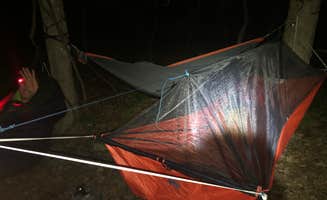Dispersed camping options near Cross River, New York include primitive sites nestled within the Hudson Valley's mixed hardwood forests. These undeveloped areas sit at elevations between 400-700 feet, creating natural drainage during wet weather conditions. The region experiences four distinct seasons with particularly vibrant fall foliage in October when temperatures range from 40°F to 65°F, making it a popular time for backcountry camping.
What to do
Trail exploration: At Taconic Hereford Multiple Use Park, hikers can access multiple unmarked paths through diverse forest terrain. One camper noted, "There is plenty of trails to explore and wildlife to enjoy, especially since these over 900 acres also back up to another huge plot of protected forests."
Wildlife observation: Early mornings provide opportunities to spot white-tailed deer, wild turkeys, and various woodland birds throughout the public lands. Dawn hours offer the best viewing conditions, especially near natural water sources.
Stargazing: The lack of developed infrastructure creates minimal light pollution at Hemlock Ridge MUA Dispersed, allowing for excellent night sky viewing. Bring binoculars during new moon phases for optimal star visibility.
What campers like
Natural isolation: The dispersed nature of sites provides privacy without designated neighbors. As one camper described Hemlock Ridge, "If you like dispersed camping, like me- this place is good. There are absolutely no amenities whatsoever & barely even a signal here, but it's quiet & off the beaten path."
Accessibility to towns: While offering wilderness experiences, these sites remain within reasonable distance to local communities. A Taconic Hereford visitor highlighted this balance: "Less than 10 min drive from town, but hiking in and finding a suitable place to make camp has the feeling of the wild."
Cost efficiency: Free camping near Cross River, New York appeals to budget-conscious outdoor enthusiasts. With no reservation requirements or entrance fees, these public lands provide economical alternatives to developed campgrounds in the region.
What you should know
Limited capacity: Parking areas restrict the number of overnight visitors. At Hemlock Ridge, "The parking lot only holds about 4-5 cars, 6 if you park real tight," making weekday visits more advisable than busy weekends.
Navigation challenges: Lack of marked trails or designated sites requires basic navigation skills. GPS devices with downloaded maps are recommended since cellular service can be unreliable in valleys and dense forest areas.
Seasonal considerations: Spring conditions often include muddy access paths between March and May. Summer months bring denser underbrush and increased insect activity, particularly after rainfall. Autumn provides more comfortable temperatures but increased weekend visitor traffic.
Tips for camping with families
Site selection: Scout appropriate camping spots during daylight hours. Flat areas with natural windbreaks and minimal undergrowth provide safer conditions for children. Allow extra time for finding suitable terrain.
Water planning: No potable water exists at these primitive sites. Families should carry 1-2 gallons per person per day, depending on activities and temperatures. Consider vehicle-based water storage with hiking transfer containers for longer stays.
Safety protocols: Establish clear boundaries for children due to unmarked terrain. The lack of defined campsite borders at Floyd Bennett Field and similar areas requires additional supervision compared to developed campgrounds with designated spaces.
Tips from RVers
Access limitations: Standard RVs cannot access these primitive camping locations. High-clearance vehicles with 4WD capabilities may reach some outer parking areas but cannot enter the camping zones themselves.
Alternative options: RV campers seeking free or low-cost camping near Cross River should consider Walmart parking lots in nearby towns (with manager permission) or day-use only at these sites while establishing base camps elsewhere.
Equipment transfer: For those determined to use these dispersed sites, consider portable camping gear that can be transferred from vehicle to site. Collapsible equipment and multiple-trip carrying systems allow RV owners to establish primitive camps beyond parking areas.



